Natural Slug & Snail Management
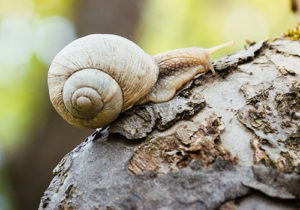 Ah, springtime in the garden. Bulbs are blooming, bumblebees are buzzing, and mollusks are slowly stirring beneath the mulch.
Ah, springtime in the garden. Bulbs are blooming, bumblebees are buzzing, and mollusks are slowly stirring beneath the mulch.
Wait.... what?
Slugs and snails — land-based cousins of marine mollusks like clams — are very much part of our garden ecosystems. Like most of the small animals that call our gardens home, they spend the winter huddled beneath a protective layer of mulch and topsoil, only to wake up with an appetite as the spring sun warms the soil.
While they may be cuter and also more helpful than we usually give them credit for, there’s no denying that slugs and snails can cause a lot of damage. They’re particularly fond of tender vegetable seedlings, but they’ll go after new growth on our annuals and perennials too.
And look, it’s not their fault: that’s just what they eat. In moderation, it might be no big deal if they nibble on a few plants here and there. But when there are a lot of slugs or snails in our gardens, we might have to take action.
When the slug and snail population gets out of hand and starts to cause serious problems, what’s a gardener to do?
Identify the (Right) Culprit
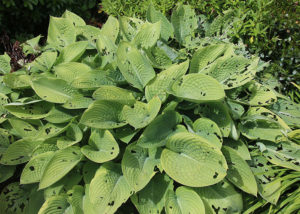 Before you go blaming slugs and snails, make sure you’ve got the right phylum. Arthropod (insect) and even chordate (mammal or bird) damage can look similar to that caused by mollusks.
Before you go blaming slugs and snails, make sure you’ve got the right phylum. Arthropod (insect) and even chordate (mammal or bird) damage can look similar to that caused by mollusks.
Take a careful look at the damaged leaves. If they have notches clipped cleanly out of them so that the damage looks like bite-marks, you’re probably dealing with an insect. In that case, start checking the undersides of leaves for caterpillars, who usually don’t go far. While a slug or snail can eat an entire small seedling down to the ground, they won’t yank plants out of the soil — that would be a bird, or possibly a squirrel or rat.
Slugs and snails have rasping tongues, which wear holes through leaves like tiny pieces of sandpaper. They will often create holes through the middle of the leaf rather than the edges. The damaged areas will be smooth and round, and sometimes there will be ragged edges or translucent “windows” in places rather than holes worn all the way through.
If you look carefully, you may or may not see the shimmering remnants of the slime these critters use to get around. Lack of a trail doesn’t rule them out. But if you do see a trail nearby, that’s a good way to confirm your diagnosis.
One thing you are unlikely to see on the scene of the crime is the culprits themselves — unless it’s an especially damp, cool, and overcast day. They prefer to do their snacking at night, when there’s less risk of drying out in the sun, and they are experts at hiding during the day.
So now that you’ve identified the damage, what are you going to do about it? Follow these holistic tips to cut down on slug and snail damage in your garden, both for the long and the short term.
"Slugs and snails have rasping tongues, which wear holes through leaves like tiny pieces of sandpaper. They will often create holes through the middle of the leaf rather than the edges."
Limit Hiding Places
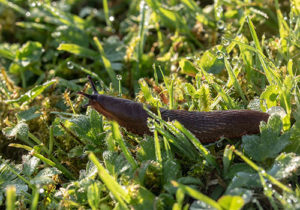 One of the best ways to cut down on the number of slugs and snails in your garden is to limit their shelter options. Nothing says “mollusk paradise” like a nice cool, dark hiding place conveniently located right by the best food in town. There will always be some slugs and snails in your garden, but there’s no reason you need to maintain a destination resort for them.
One of the best ways to cut down on the number of slugs and snails in your garden is to limit their shelter options. Nothing says “mollusk paradise” like a nice cool, dark hiding place conveniently located right by the best food in town. There will always be some slugs and snails in your garden, but there’s no reason you need to maintain a destination resort for them.
Look around your garden for any unnecessary boards, large stones or bricks, tarps, or leaf piles — anything that creates shade, holds in moisture, and provides protection from the elements. Remove these completely if you can, or move them further away from your vegetables and other tender leafy plants. (Keep in mind that in the fall and winter time, leaf piles make excellent shelter for beneficial bugs like pollinators and predatory insects. Deciding where to keep leaf material is always a balancing act.)
If you have an unmovable structure like a deck or shed, consider growing veggies and other slug and snail favorites as far from it as possible. The more open ground a slug or snail needs to cross between daytime snoozing and nighttime feasting, the less appealing the location will seem to your uninvited guests.
Encourage Natural Predators
Believe it or not, there are plenty of critters who love a slimy snack. Even as you’re making your garden less welcoming to slugs and snails, you can make it more welcoming to their natural predators.
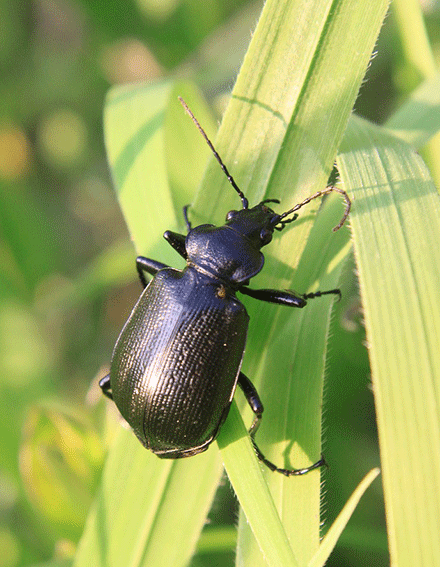
Build a beetle bump Ground beetles — which you may know as “those big shiny black bugs” — are amazing beneficial insects that eat all kinds of pests, including baby slugs and snails. Even though they may startle us from time to time, they are great garden friends to have around.
A “beetle bump” is just a little hill of soil, maybe a foot or two across. Since it’s raised up above ground level, it’ll drain quickly in the rain and provide a nice place for beetles to burrow. Adding native bunch-grasses and wildflowers will make your beetles feel right at home. One bump will be plenty for a small garden. Those with larger gardens may want to build a few.
Welcome wild birds Backyard birds are as helpful as they are entertaining. And yes, many of them eat slugs and snails. There are many ways to attract more wild birds to your garden, but one of the best is to plant the most diverse assortment of native trees and shrubs that you can. Not only will these plants provide food and shelter for birds in themselves, but native plants are more likely to attract the native insects birds recognize as food.
Let poultry loose Ducks will famously eat even rather large slugs and snails. Chickens can be more picky, but don’t mind gobbling up eggs and babies. If you’re the proud owner of a backyard flock, why not put your birds to work? You can let them roam freely if you don’t have any vulnerable crops planted in the off-season, or temporarily fence them in where you want them.
Through the fall, winter, and early spring, slugs and snails hunker down just beneath the surface of the soil. Their eggs, too, tend to be shallowly buried. So whenever a bed is between crops, just let chickens do what they do best — scratching away and pecking up the tasty treats they find.
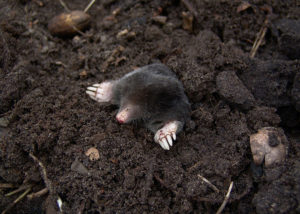 Embrace snakes & moles Okay, they aren’t everyone’s favorite wildlife. But while moles may accidentally uproot your carrots from time to time, they won’t intentionally cause any harm. They’ll almost certainly do less damage than a large mollusk population, and they’ll eat other pests too. And easy-going garter snakes pose no threat to children or pets and never damage plants at all.
Embrace snakes & moles Okay, they aren’t everyone’s favorite wildlife. But while moles may accidentally uproot your carrots from time to time, they won’t intentionally cause any harm. They’ll almost certainly do less damage than a large mollusk population, and they’ll eat other pests too. And easy-going garter snakes pose no threat to children or pets and never damage plants at all.
All in all, these garden friends are definitely among the many less-loved members of our garden ecosystems who deserve a second chance.
Welcome garter snakes with native ground covers to slither through, cozy rock walls, and ground-level water sources. As for moles, most of us don’t struggle to attract them. But they appreciate the same moist, well-drained, rich soil that helps most of our favorite plants thrive.
"It sounds both tedious and gross, and it certainly can be, but hand-picking slugs and snails off of your vegetation is one of the most effective methods for home gardeners."
Get Your Hands Dirty
If you don’t have time to wait for the local wildlife to take care of your slugs and snails, you may need to take matters into your own hands. It sounds both tedious and gross, and it certainly can be, but hand-picking slugs and snails off of your vegetation is one of the most effective methods for home gardeners.
Don’t forget — slugs and snails are nocturnal. You’ll need to get your headlamp out for this. You’ll also need a smooth-sided bucket containing either cheap beer or water with a dash of biodegradable soap. You could also use salty water, but you’d need to dispose of it somewhere other than your garden to avoid harming the soil. Optional equipment: a raincoat for hunting in optimally drizzly conditions, and gloves to protect your hands from slime.
The rest is pretty self-explanatory: pick up those slimy critters and plop them in your bucket. Check the undersides of leaves, and in all the little nooks and crannies you can find. Instead of dunking them, you could also squish them, but most people find the former option somewhat less unpleasant.
For this method to work, you’ll need to stick with it. If you’re dealing with a large population, it would be best to go out nightly until you start to notice a population decrease. Then you can dial it back to once a week. Keep in mind that even though this method is more time-consuming than the ones listed below, it’s also typically more effective.
"Hollowed-out watermelon halves make great traps, as do old pieces of plywood."
Build Traps
A variation on hand-picking that some gardeners find more convenient is to tempt your slugs and snails to congregate in a predictable hiding place, then nab them while they’re napping in the middle of a nice sunny day.
This will work best if you’ve already followed the directions above to remove their other hiding places, and if your garden has more open space than dense vegetation.
Hollowed-out watermelon halves make great traps, as do old pieces of plywood. Make sure there’s a small gap between your trap and the ground, but that the space underneath is cool, damp, and dark. In the evening before a day that’s expected to be sunny and warm, place your tempting hidey-holes near the plants your slugs and snails like best. When the sun is high in the sky, check your trap and dispose of the contents however you see fit. Keep this up at least until you notice a pattern of fewer and fewer victims, and repeat as needed.
There’s also the infamous “beer trap,” consisting of a buried smooth-sided container with an entrance at ground level. The idea is that slugs are attracted to the beer and then fall in and can’t get out. The biggest limitation of this method is that slugs can’t smell the beer from further than a few feet away. So it’s worth a try, but probably only if you’re up for setting several traps. By the way, non-alcoholic beer works too, as does sugar-water mixed with yeast.
Keep Them Out
We want to say this right up front: While some gardeners have success with the methods below, others find that no barrier seems to keep their slugs and snails out. We think it’s worth a try in combination with other methods listed here, but it probably won’t solve your problem alone.
Of the materials sometimes recommended for excluding slugs and snails, copper is the only one with scientific results behind it. Copper reacts with chemicals in mollusk slime to create an unpleasant sensation. It won’t kill or harm them, just encourage them to find a meal elsewhere.
Copper works best when it’s applied in an unbroken ring around containers or raised beds. If there’s a gap that slugs and snails can slip through, they’ll find it. It also works best when it’s untarnished. You can clean it with vinegar to keep it effective.
Of course, copper won’t do anything about slugs that are already inside the area you’re trying to protect. So you’ll likely need to combine this with hand picking and/or bait.
There’s no harm in trying other exclusion methods too — there are gardeners out there who swear by each of them. Just be aware that results vary. Other materials gardeners sometimes apply around their plants as deterrents include jagged eggshells, large piles of dry diatomaceous earth, and wool.
"The least-toxic active bait ingredient you’ll want to look for is iron phosphate."
Use the Least Toxic Bait
Like copper barriers, bait is legitimately helpful but usually not a sufficient solution by itself. It might be all you need to keep a small slug or snail population small, and it can work in combination with the other methods above to gradually reduce a large population. But if you’re expecting to solve your major problem quickly and conveniently using bait alone, you’re setting yourself up for disappointment.
If you want to use bait as part of your mollusk management plan, make sure to use one that won’t harm you, kids, pets, or wildlife. Some slug and snail baits are made of nasty stuff called metaldehyde, which can be lethal both to domesticated pets and to any wildlife that eats a slug that died from it.
The least-toxic active ingredient you’ll want to look for is iron phosphate. Sluggo® is one popular brand of iron phosphate bait that is labeled for organic gardening. While anything can be toxic in large enough doses, it would be difficult for any non-mollusk to eat enough iron phosphate to cause serious harm. Meanwhile, even small amounts will cause slugs and snails to stop feeding immediately and then gradually sicken and die. Don’t expect visible evidence of the effects, though. Since iron phosphate acts gradually, slugs and snails will slink off to die peacefully in their hiding places.
Here are a few more tips for success with Sluggo® or another iron phosphate bait: Apply enough of it at a time (follow the directions on the package), place it strategically near those dark hiding places your mollusks love so much, and reapply it every time it rains.
Find the Right Balance for Your Garden
So what’s the best method? The answer is that there isn’t one answer. Removing hiding places and increasing predator habitat will likely have the biggest impact in the long-term but might not show noticeable results right away. Hand-picking can make a big difference quickly when done right, but it takes the most time and energy. Bait is convenient, but its effectiveness is limited. For most gardeners, the best plan is probably to combine several of these methods together.
Keep in mind, the goal here is not to eradicate every single slug or snail in your garden for all eternity, but to restore a balance between plants, mollusks, and the predators that eat them. It may take some time to bring your ecosystem back in line, but it’ll be worth it in the end. With a little patience and a combination of a few mollusk management strategies, you can stop stressing about slime trails and get back to enjoying your share of the harvest.

